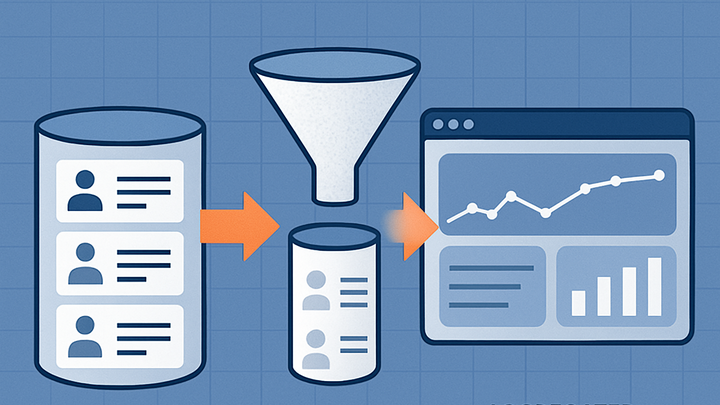Published on 2025-06-22T02:43:48Z
What is Data Anonymization? Examples and Tools
Data anonymization is the process of transforming datasets to prevent the identification of individuals. It removes or obfuscates personally identifiable information (PII) so that data can be analyzed without compromising privacy. In analytics, anonymized data retains critical metrics and insights, enabling teams to make data-driven decisions without exposure to sensitive user identifiers. This practice is increasingly important due to stringent data protection regulations like GDPR and CCPA, which mandate strong privacy safeguards. Effective anonymization balances data utility and privacy, ensuring that datasets remain useful for analysis while safeguarding user trust. Tools like plainSignal and Google Analytics 4 provide built-in anonymization features to streamline implementation and compliance. Ultimately, data anonymization is essential for ethical, legal, and secure analytics.
Data anonymization
Removing PII from data to protect user privacy in analytics while ensuring compliance and preserving analytical value.
Why Data Anonymization Matters in Analytics
Data anonymization removes or modifies identifying information in datasets, making it impossible to link records back to individuals. This protects user privacy and reduces legal risks when collecting and analyzing user behavior. In analytics, anonymized data still retains valuable insights for decision-making without exposing personal identifiers. With increasing regulatory requirements and consumer awareness around data privacy, anonymization has become a core best practice. Balancing data utility and privacy is key to responsible analytics.
-
Protecting user privacy
By anonymizing data, companies prevent the misuse of PII and safeguard individual identities even if data is breached or shared.
-
Compliance with regulations
Anonymization helps meet GDPR, CCPA and other data protection standards by stripping personal identifiers.
-
Maintaining trust
Demonstrating strong privacy practices builds user trust and brand reputation.
-
-
Balancing utility and privacy
Anonymization must preserve analytical value while eliminating identifiers; finding the right balance avoids data distortion.
-
Information loss
Over-anonymization can reduce data granularity and skew insights.
-
Privacy metrics
Use metrics like k-anonymity scores to quantify the level of anonymity.
-
-
Regulatory drivers
Laws and industry standards increasingly require companies to anonymize user data to avoid penalties and data misuse.
-
Gdpr requirements
Under GDPR, truly anonymized data falls outside its scope, reducing compliance complexity.
-
Ccpa considerations
CCPA encourages de-identification methods and prescribes standards for pseudonymization.
-
Techniques of Data Anonymization
Several techniques exist to anonymize data, each with trade-offs. Choosing the right method depends on the use case, data sensitivity and desired analytical outcomes. Common approaches include k-anonymity, differential privacy, and pseudonymization.
-
K-anonymity
This technique groups records into sets of at least k indistinguishable entries, preventing re-identification through unique combinations.
-
Generalization
Replace specific values with broader categories to increase group sizes.
-
Suppression
Remove or mask outlier attributes that could uniquely identify records.
-
-
Differential privacy
Introduces statistical noise to query results, making it mathematically improbable to infer information about any single individual.
-
Noise mechanisms
Apply Laplace or Gaussian noise calibrated to a privacy budget (epsilon).
-
Privacy budget
Limits total noise exposure to balance accuracy and privacy guarantees.
-
-
Pseudonymization
Replaces identifiers with artificial IDs or keys; data can be re-linked only if the key mapping is kept separately.
-
Reversibility
Unlike true anonymization, pseudonymized data can be re-identified with the key.
-
Use cases
Commonly used when you need to maintain data lineage for support or further analysis.
-
Implementing Data Anonymization with SaaS Tools
Modern analytics platforms offer built-in features to anonymize or pseudonymize data. Leveraging these can simplify compliance and reduce development overhead.
-
PlainSignal
plainSignal is a lightweight, cookie-free analytics tool that automatically anonymizes user data by default. To integrate on your website, include the following snippet:
-
Integration code
Embed this in your HTML to start collecting anonymized analytics data:
<link rel="preconnect" href="//eu.plainsignal.com/" crossorigin /> <script defer data-do="yourwebsitedomain.com" data-id="0GQV1xmtzQQ" data-api="//eu.plainsignal.com" src="//cdn.plainsignal.com/plainsignal-min.js"></script> -
Data retention
plainSignal retains only aggregated metrics and discards raw event data shortly after processing.
-
-
Google analytics 4 (GA4)
GA4 provides IP anonymization features to strip the last octet of client IPs before storage. To enable, add the following configuration:
-
Enable anonymize_ip
In your gtag config, set ‘anonymize_ip’: true to activate IP masking.
-
Impact on accuracy
Anonymizing IPs may slightly affect geographic precision but maintains overall trend analysis.
-
-
Custom server-side anonymization
For advanced control, implement server-side processing to strip or hash PII before forwarding to analytics tools.
-
Pre-processing
Intercept analytics payloads and remove or hash fields like email or userId.
-
Hashing techniques
Use salted hashes to pseudonymize identifiers without storing the salt on analytics servers.
-
Best Practices and Considerations
While anonymization strengthens privacy, it requires careful design and ongoing monitoring. Follow best practices to ensure robust data protection without sacrificing analytic insights.
-
Minimize data collection
Collect only necessary attributes and avoid storing raw PII when it’s not required.
-
Field audits
Regularly review collected fields to remove unnecessary PII.
-
-
Document anonymization policies
Maintain clear documentation of methods, tools, and parameters used for anonymization.
-
Audit trails
Log changes to anonymization workflows and configuration settings.
-
Version control
Use versioning for scripts and code to track updates and rollbacks.
-
-
Assess re-identification risks
Periodically evaluate if anonymization methods still protect against modern re-identification techniques.
-
Privacy testing
Simulate attacks to attempt re-identification and measure resistance.
-
Keep up with research
Monitor academic and industry developments in privacy attacks and defenses.
-
